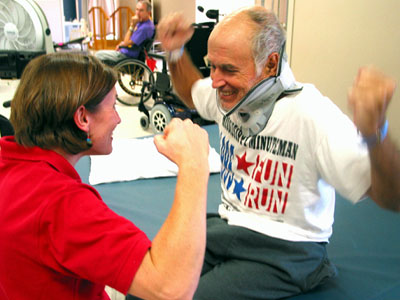FLOWOOD, Miss.—Robert Thomas of Flowood used to begin his days with a brisk 4-mile walk, followed by coffee with his buddies at the Burger King.
Now his routine revolves around his therapy schedule at Methodist Rehabilitation Center in Jackson, where’s he’s fighting to recover from a paralyzing spinal cord injury.
Thomas arrived at the Jackson hospital Oct. 30, this hunting season’s first victim of a tree stand-related injury in Mississippi.
“When I started down the ladder, a rail broke and it threw me,” said Thomas, 68. “I fell about 12 or 13 feet.”
The plunge left Thomas a paraplegic, a fate shared by many hunters who fall from the lofty perches.
Dr. David Collipp, a physical medicine physician at Methodist, said tree stand accidents are probably the third most common cause of spinal cord injuries in Mississippi. “Such falls also are associated with brain injuries and any number of fractures.”
Maj. Stephen Adcock, hunter education administrator for the Mississippi Department of Wildlife, Fisheries and Parks, says about 50 percent of deer hunting injuries involve tree stands. During the 2001-2003 hunting seasons, there were 19 tree stand incidents, two involving fatalities.
When it comes to preventing tree stand incidents, most safety experts say hunters need to avoid “user errors.”
“Some injuries are related to alcohol consumption and many are related to improperly erected or constructed tree stands,” said Dr. Collipp.
Thomas admits that one of his follies was building his shooting house out of untreated lumber, which left it more susceptible to weathering. His other mistake was not checking the stand for rotten boards as he climbed skyward.
Adcock said hunters also should be cautious using store-bought stands and pay particular attention to safety instructions. “Most tree stands come with an instructional tape and you need to follow the rules and be careful,” Adcock said.
Adcock also recommends wearing a fall-restraint device and not climbing too high. “I know we had someone fall from 45 feet who didn’t live,” Adcock said.
Collipp said tree stand falls can be especially debilitating because medical assistance is delayed. Hunters often aren’t found until hours after being injured or they’re in areas where rescue vehicles can’t reach them.
Rescue workers hauled Thomas out of the woods in a four-wheel drive pick-up, and he was taken by ambulance to a hospital in Carthage. He was then air-lifted to the University of Mississippi Medical Center in Jackson, where he underwent surgery to stabilize his spine.
“When he came here he needed maximum assistance,” said Methodist physical therapist Cathy Henderson. “We’re working on his strength and endurance and balance. When he leaves here, he’ll be able to transfer in and out of bed with a sliding board. We’re ordering him a power wheelchair to get around in since he lives on five acres in Flowood.”
Encouraged by his gains in therapy and buoyed by well wishes from his walking pals and coffee buddies, Thomas says he’s “getting on pretty good.”
And he’s committed to getting even better. “I’m going to try to do whatever the therapists ask me to do,” he said. “They know more about this than I do and I’m going to rely on them.”
Some of Thomas’ visitors have shared their own tales of harrowing tree stand experiences, and he’s now offering his own story as a word to the wise.
“I’d advise anyone before getting into any type of deer stand to examine it and make sure it’s safe and sound,” Thomas said. “I was a little careless.”
Ten Tips for Tree Stand Safety
- Always wear a fall-restraint device. Wear it from the time you leave the ground until you return to the ground.
- Read and follow manufacturer’s instructions and warnings.
- Practice with your tree stand at a low level, under 5 feet, until you are sure you know how to use the stand.
- Check your stand before and after each use. Correct problems before using stand again.
- Take your time when climbing and watch every step you make.
- Never climb with anything in your hands. Use a pull rope to bring up equipment after you’re secure in your stand.
- Watch the weather. Some tree stands will slip on wet trees. Most stands are made of metal and are not safe during lightening storms.
- Do not sleep in tree stands or drink alcohol or take drugs during tree stand use.
- Tell someone exactly where you will be hunting and what time you plan to return. Agree that they will search for you if you do not return within an hour of that time.
- Take a whistle, flashlight, cell phone or two-way radio so you can signal rescuers with your location.
Source: “The User’s Guide to The Tree Stand (Its History and Safe Use)” by L.J. Smith

